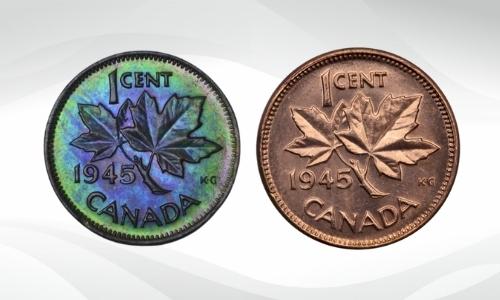Last updated on May 2nd, 2024 at 03:32 pm
Last Updated on May 2, 2024 Posted by Colonial Acres Coins
Canadian proof set coins are a beautiful addition to any coin collection, but how can you find great quality in the secondary market? The key is understanding coin collection terminology. For example, specific phrases describe how coins age, a natural process that affects their appearance and possibly their worth.
While getting familiar with this jargon may initially feel intimidating, learning what each term means isn’t as difficult as you may fear. In fact, we’ve broken down the most common phrases and offered a few tips on how to find interesting, authentic coins for your collection.
Coins Tone Over Time
“Toning” is coin collecting lingo for discolouration. Metal chemically interacts with air over time, and these minor but ongoing reactions can create residue or alter the surface colour. Toning happens on a scale and typically intensifies over time. For example, Chinese zodiac coins made in 2008 will tend to have a lighter toning than those made in 1998.

Does toning decrease coins’ value? You may be surprised to hear it sometimes does the opposite.
Depending on the co
in’s overall condition, toning can actually make it more valuable because it adds uniqueness. All new coins look the same, but the natural toning process takes a different path for every coin. However, for collectible releases in particular, toning is considered an impairment of the coin’s original beauty.
Errors Are Intrinsic Parts of the Coin
Sometimes things go wrong during the minting process, and the finished currency doesn’t look like it should. When this happens, the resulting deviations are called “errors.” These can actually add to coins’ value, as the currency is much rarer than correctly manufactured pieces.
There are a few errors that can occur during the minting process:
- Planchet Errors: When the metal blank used to create coins is abnormal, it results in a planchet error.
- Striking Errors: If the error occurs when the die imprints the coin with an image (known as “striking”), it’s considered a striking error.
- Die Errors: When the die is used incorrectly or damaged, the resulting coin has a die error.
Impairments Come in Many Forms
You may come across coins listed as “impaired.” Unlike errors, impairments happen after the minting process and are usually caused by neglect. For example, coins kept as loose change may get “scuffed” by rubbing against other metal, resulting in scratches.
“Residue” is a common impairment when coins are stored in packaging with sticky surfaces, such as envelopes. This stickiness transfers to the coin over time.
In some cases, the packaging is degraded, damaged or missing. Paper packaging naturally ages, so this impairment is more common with older coins.
No matter the cause, all impairments should be clearly pointed out in product descriptions. Here are a few others you may see as you shop:
- Circulation wear
- Gouges
- Cleaning evidence
- Nicks
- Contact marks
- Smudges
- Fingerprints
Does impairment make a coin worthless? It absolutely does not. While some impairments may decrease the monetary value, coin collecting is about more than the price tag. Impaired coins still hold historical and sentimental valu
e, and collectors who want to complete sets may consider them a boon since they’re more affordable than coins in perfect condition.
You Can Find Authentic Coins From Colonial Acres
The Royal Canadian Mint authorizes reliable collectible coin dealers so customers know they can trust these vendors. Dealers showcase their wares in a variety of venues:
- Storefronts
- Online shops
- Auctions
- Coin shows
Whether you’re just starting your collection or adding to an expansive one, Colonial Acres Coins is the perfect place to shop for intriguing finds. Our selection covers a wide range of dates and cultures, and we’re happy to help you find exactly what you’re looking for. To check out what we have in stock, visit us online. If you have any questions, give us a call.




